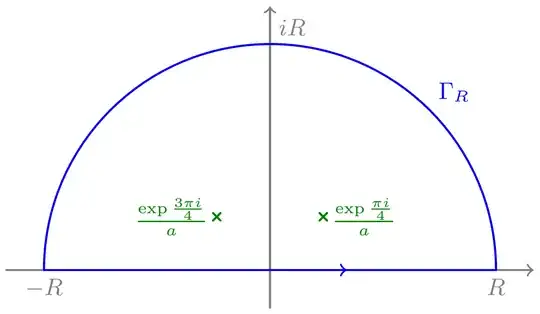Trigonometric Reduction
$$
\begin{align}
&\int_0^\infty\frac{\log\left(1+x^4\right)}{1+x^2}\,\mathrm{d}x\\
&=\int_0^{\pi/2}\log\left(1+\tan^4(x)\right)\,\mathrm{d}x\tag{1a}\\
&=\int_0^{\pi/2}\log\left(\cos^4(x)+\sin^4(x)\right)\,\mathrm{d}x-4\int_0^{\pi/2}\log(\cos(x))\,\mathrm{d}x\tag{1b}\\
&=\int_0^{\pi/2}\log\left(1-2\sin^2(x)\cos^2(x)\right)\,\mathrm{d}x-4\int_0^{\pi/2}\log(\cos(x))\,\mathrm{d}x\tag{1c}\\
&=\int_0^{\pi/2}\log\left(1-\frac12\sin^2(2x)\right)\,\mathrm{d}x-4\int_0^{\pi/2}\log(\cos(x))\,\mathrm{d}x\tag{1d}\\
&=\frac12\int_0^\pi\log\left(1-\frac12\sin^2(x)\right)\,\mathrm{d}x-4\int_0^{\pi/2}\log(\cos(x))\,\mathrm{d}x\tag{1e}\\
&=\int_0^{\pi/2}\log\left(1-\frac12\sin^2(x)\right)\,\mathrm{d}x-4\int_0^{\pi/2}\log(\cos(x))\,\mathrm{d}x\tag{1f}\\
&=\int_0^{\pi/2}\log\left(1-\frac12\cos^2(x)\right)\,\mathrm{d}x-4\int_0^{\pi/2}\log(\cos(x))\,\mathrm{d}x\tag{1g}\\
\end{align}
$$
Explanation:
$\text{(1a):}$ substitute $x\mapsto\tan(x)$
$\text{(1b):}$ add and subtract the integral of $\log\left(\cos^4(x)\right)$
$\text{(1c):}$ $\cos^4(x)+\sin^4(x)=\left(\cos^2(x)+\sin^2(x)\right)^2-2\sin^2(x)\cos^2(x)$
$\text{(1d):}$ $\sin(2x)=2\sin(x)\cos(x)$
$\text{(1e):}$ substitute $x\mapsto x/2$ in the left integral
$\text{(1f):}$ apply the symmetry of $\sin(x)$ about $\frac\pi2$
$\text{(1g):}$ substitute $x\mapsto\frac\pi2-x$ in the left integral
Computation of the Left Integral
$$
\begin{align}
&\int_0^{\pi/2}\cos^{2n}(x)\,\mathrm{d}x\tag{2a}\\
&=\int_0^{\pi/2}\cos^{2n-1}(x)\,\mathrm{d}\sin(x)\tag{2b}\\
&=(2n-1)\int_0^{\pi/2}\sin^2(x)\cos^{2n-2}(x)\,\mathrm{d}x\tag{2c}\\
&=(2n-1)\int_0^{\pi/2}\cos^{2n-2}(x)\,\mathrm{d}x-(2n-1)\int_0^{\pi/2}\cos^{2n}(x)\,\mathrm{d}x\tag{2d}\\
&=\frac{2n-1}{2n}\int_0^{\pi/2}\cos^{2n-2}(x)\,\mathrm{d}x\tag{2e}
\end{align}
$$
Explanation:
$\text{(2b):}$ prepare to integrate by parts
$\text{(2c):}$ integrate by parts
$\text{(2d):}$ $\sin^2(x)=1-\cos^2(x)$
$\text{(2e):}$ add $\frac{2n-1}{2n}$ times $\text{(2a)}$ to $\frac1{2n}$ times $\text{(2c)}$
Apply $(2)$ inductively to obtain
$$
\int_0^{\pi/2}\cos^{2n}(x)\,\mathrm{d}x=\frac{\pi/2}{4^n}\binom{2n}{n}\tag3
$$
To apply $(3)$ to the integral, we will use the series
$$
\begin{align}
\sum_{n=0}^\infty\binom{2n}{n}x^n&=\frac1{\sqrt{1-4x}}\tag{4a}\\
\sum_{n=1}^\infty\binom{2n}{n}x^{n-1}&=\frac4{\sqrt{1-4x}\left(1+\sqrt{1-4x}\right)}\tag{4b}\\
\sum_{n=1}^\infty\frac1n\binom{2n}{n}x^n&=2\log\left(\frac2{1+\sqrt{1-4x}}\right)\tag{4c}\\
\end{align}
$$
Explanation:
$\text{(4a):}$ the Extended Binomial Theorem
$\text{(4b):}$ subtract $1$ and divide by $x$
$\text{(4c):}$ integrate using $\frac{\mathrm{d}}{\mathrm{d}x}\sqrt{1-4x}=-\frac2{\sqrt{1-4x}}$
Finally,
$$
\begin{align}
\int_0^{\pi/2}\log\left(1-\alpha\cos^2(x)\right)\,\mathrm{d}x
&=-\sum_{n=1}^\infty\frac{\alpha^n}n\int_0^{\pi/2}\cos^{2n}(x)\,\mathrm{d}x\tag{5a}\\
&=-\sum_{n=1}^\infty\frac{\alpha^n}n\frac{\pi/2}{4^n}\binom{2n}{n}\tag{5b}\\
&=\pi\log\left(\frac{1+\sqrt{1-\alpha}}2\right)\tag{5c}
\end{align}
$$
Explanation:
$\text{(5a):}$ apply the series for $\log(1-x)$
$\text{(5b):}$ apply $(3)$
$\text{(5c):}$ apply $\text{(4c)}$ with $x=\frac\alpha4$
Computation of the Right Integral
Although we can use $(5)$, with $\alpha=1$, to compute the following integral, the following approach not only displays a different method, but also is more direct and simpler.
$$
\begin{align}
\int_0^{\pi/2}\log(\cos(x))\,\mathrm{d}x
&=\int_0^{\pi/2}\log(\sin(x))\,\mathrm{d}x\tag{6a}\\
&=\frac12\int_0^{\pi/2}\log\left(\frac12\sin(2x)\right)\,\mathrm{d}x\tag{6b}\\
&=\frac12\int_0^{\pi/2}\log\left(\frac12\sin(x)\right)\,\mathrm{d}x\tag{6c}\\[3pt]
&=-\frac\pi2\log(2)\tag{6d}
\end{align}
$$
Explanation:
$\text{(6a):}$ substitute $x\mapsto\frac\pi2-x$
$\text{(6b):}$ average the two sides of $\text{(6a)}$
$\text{(6c):}$ substitute $x\mapsto x/2$
$\phantom{\text{(6c):}}$ apply the symmetry of $\sin(x)$ about $\frac\pi2$
$\text{(6d):}$ subtract $\text{(6a)}$ from two times $\text{(6c)}$
The Complete Integral
$$
\begin{align}
&\int_{-\infty}^\infty\frac{\log\left(1+x^4\right)}{1+x^2}\,\mathrm{d}x\\
&=2\int_0^\infty\frac{\log\left(1+x^4\right)}{1+x^2}\,\mathrm{d}x\tag{7a}\\
&=2\int_0^{\pi/2}\log\left(1-\frac12\cos^2(x)\right)\,\mathrm{d}x-8\int_0^{\pi/2}\log(\cos(x))\,\mathrm{d}x\tag{7b}\\
&=2\pi\log\left(\frac{2+\sqrt2}4\right)-8\left(-\frac\pi2\log(2)\right)\tag{7c}\\[3pt]
&=2\pi\log\left(2+\sqrt2\right)\tag{7d}
\end{align}
$$
Explanation:
$\text{(7a):}$ the integrand is even
$\text{(7b):}$ apply $\text{(1g)}$
$\text{(7c):}$ apply $(5)$ with $\alpha=\frac12$ and $(6)$
$\text{(7d):}$ simplify
